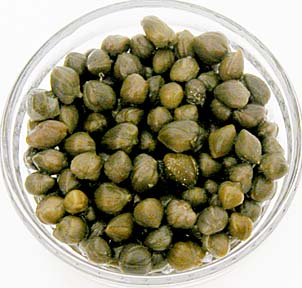
Eleanor Nakama-Mitsunaga

|
This unique condiment is easily found in supermarkets near other cured items such as olives. It's used to add a bit of tang and piquancy to recipes, but what exactly are capers?The basics: Capers are the flower buds of a shrub that flourishes in the Mediterranean region. The use of capers dates to 3000 B.C., when it was mentioned as a food item in the "Epic of Gilgamesh," one of the oldest written stories from ancient Sumeria.
The tiny, green buds are hand-picked, then immediately placed in a brine solution for a couple of months, or dried and packed in salt. They have a unique tangy and lemony flavor that marries well with seafood, poultry and pasta dishes.
Caperberries, which have grown popular in recent years, differ from capers in that they are the fruit of the plant, not the buds.
Selecting: Capers are generally sold bottled in a vinegar and brine solution. Most bottles will refer to "nonpareil" or "nonpareille," the smallest and finest grade of capers. Larger capers are called "capote" and are not as prized.
Storing: Capers bottled in brine should be refrigerated after opening and should last several months. Capers packed in salt can be left in the pantry or in the refrigerator for longer storage.
Use: Capers are used straight out of the bottle. Drain the brine completely or use some in cooking, depending on the recipe. Capers packed in salt should be rinsed. Add capers toward the end of the cooking process.
Some popular uses are in tapenades, chicken piccata, veal scalloppine, remoulade sauce and as an accompaniment to smoked salmon. Try also using capers in salad dressings and marinades for fish and chicken.
Where to buy: Capers run from $2 to $5 a bottle, depending on quality and quantity and can be found at most supermarkets. Capers packed in salt are generally more expensive and can be found sporadically at specialty food stores.
Eleanor Nakama-Mitsunaga is
a free-lance food writer. Contact her
online through features@starbulletin.com

